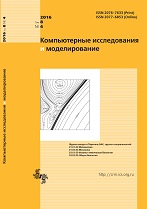|
This article is cited in 7 scientific papers (total in 7 papers)
MODELS IN PHYSICS AND TECHNOLOGY
High-Reynolds number calculations of turbulent heat transfer in FlowVision software
S. V. Zhluktov, A. A. Aksenov, D. V. Savitskiy
Joint Institute for High Temperatures RAS,
13 Izhorskaya str., Moscow, 125412 , Russia
Abstract:
This work presents the model of heat wall functions FlowVision (WFFV), which allows simulation of non-isothermal flows of fluid and gas near solid surfaces on relatively coarse grids with use of turbulence models. The work follows the research on the development of wall functions applicable in wide range of the values of quantity y+. Model WFFV assumes smooth profiles of the tangential component of velocity, turbulent viscosity, temperature, and turbulent heat conductivity near a solid surface. Possibility of using a simple algebraic model for calculation of variable turbulent Prandtl number is investigated in this study (the turbulent Prandtl number enters model WFFV as parameter). The results are satisfactory. The details of implementation of model WFFV in the FlowVision software are explained. In particular, the boundary condition for the energy equation used in high-Reynolds number calculations of non-isothermal flows is considered. The boundary condition is deduced for the energy equation written via thermodynamic enthalpy and via full enthalpy. The capability of the model is demonstrated on two test problems: flow of incompressible fluid past a plate and supersonic flow of gas past a plate (M = 3).
Analysis of literature shows that there exists essential ambiguity in experimental data and, as a consequence, in empirical correlations for the Stanton number (that being a dimensionless heat flux). The calculations suggest that the default values of the model parameters, automatically specified in the program, allow calculations of heat fluxes at extended solid surfaces with engineering accuracy. At the same time, it is obvious that one cannot invent universal wall functions. For this reason, the controls of model WFFV are made accessible from the FlowVision interface. When it is necessary, a user can tune the model for simulation of the required type of flow.
The proposed model of wall functions is compatible with all the turbulence models implemented in the FlowVision software: the algebraic model of Smagorinsky, the Spalart-Allmaras model, the SST $k-\omega$ model, the standard $k-\epsilon$ model, the $k-\epsilon$ model of Abe, Kondoh, Nagano, the quadratic $k-\epsilon$ model, and $k-\epsilon$ model FlowVision.
Keywords:
turbulent boundary layer, high-Reynolds number calculations, wall functions, incompressible fluid, compressible gas, non-isothermal flow, heat flux, plate.
Received: 04.04.2018
Revised: 31.05.2018
Accepted: 23.06.2018
Citation:
S. V. Zhluktov, A. A. Aksenov, D. V. Savitskiy, “High-Reynolds number calculations of turbulent heat transfer in FlowVision software”, Computer Research and Modeling, 10:4 (2018), 461–481
Linking options:
https://www.mathnet.ru/eng/crm458 https://www.mathnet.ru/eng/crm/v10/i4/p461
|

| Statistics & downloads: |
| Abstract page: | 224 | | Full-text PDF : | 90 | | References: | 34 |
|




 Contact us:
Contact us: Terms of Use
Terms of Use
 Registration to the website
Registration to the website Logotypes
Logotypes








 Citation in format
Citation in format 
